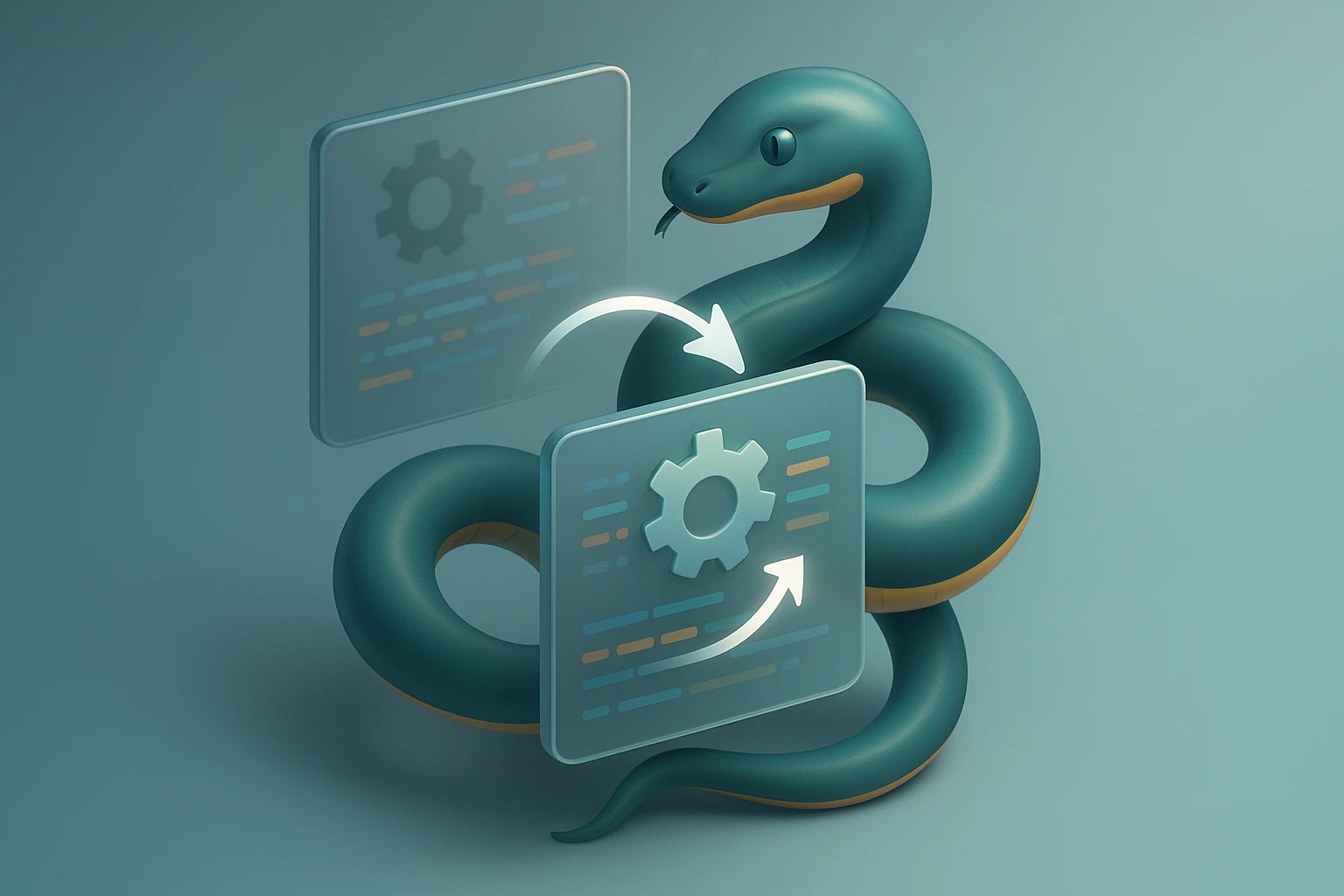What Is a Lambda Function?
Illustration of a lambda function: a small anonymous function used inline to compute a value or transform data, showing parameters, a lambda symbol, and input/output flow. Diagram.

What Is a Lambda Function?
In the rapidly evolving landscape of modern software development, understanding efficient programming constructs has become essential for developers at all levels. Lambda functions represent one of those fundamental concepts that bridge the gap between traditional programming paradigms and functional programming approaches, offering developers a powerful tool for writing cleaner, more maintainable code. Whether you're building web applications, processing data, or automating cloud infrastructure, lambda functions have likely touched your work in ways you might not even realize.
At its core, a lambda function is an anonymous, inline function that can be defined without a formal name and typically consists of a single expression. These compact code constructs allow developers to create small, throwaway functions on the fly without the ceremony of traditional function declarations. The concept originated from lambda calculus in mathematical logic but has been adopted across numerous programming languages, from Python and JavaScript to Java and C#, each with its own syntax and implementation nuances.
Throughout this comprehensive exploration, you'll discover the theoretical foundations and practical applications of lambda functions across different programming ecosystems. We'll examine their syntax variations, explore real-world use cases, compare them with traditional functions, and understand when they shine brightest in your codebase. You'll also gain insights into their role in serverless computing architectures, learn best practices for their effective use, and understand common pitfalls to avoid. By the end, you'll have a thorough understanding of how lambda functions can streamline your development workflow and enhance code readability.
Understanding the Fundamentals of Lambda Functions
Lambda functions emerged from the mathematical concept of lambda calculus, developed by mathematician Alonzo Church in the 1930s. This theoretical framework provided a formal system for expressing computation through function abstraction and application. When programming languages began adopting functional programming principles, they borrowed this lambda notation to create what we now call lambda functions or lambda expressions.
The defining characteristic of lambda functions is their anonymous nature—they exist without a formal identifier or name in the traditional sense. Unlike regular functions that require a declaration with a specific name, lambda functions are defined inline, exactly where they're needed. This immediacy makes them particularly useful for short operations that don't warrant the overhead of a full function definition.
"The beauty of lambda functions lies in their ability to express intent clearly and concisely, reducing the cognitive load on developers who read the code later."
Another crucial aspect of lambda functions is their typical limitation to single expressions. While traditional functions can contain multiple statements, complex logic, and various control structures, lambda functions are generally restricted to a single evaluable expression. This constraint isn't a limitation but rather a design philosophy that encourages developers to keep these functions simple and focused on a single purpose.
Lambda functions are first-class citizens in languages that support them, meaning they can be assigned to variables, passed as arguments to other functions, returned from functions, and stored in data structures. This flexibility enables powerful programming patterns like higher-order functions, callbacks, and functional composition that form the backbone of modern programming paradigms.
Syntax Variations Across Programming Languages
The implementation of lambda functions varies significantly across programming languages, though the underlying concept remains consistent. In Python, lambda functions use the keyword "lambda" followed by parameters, a colon, and the expression to evaluate. For example, a simple lambda that squares a number looks like: lambda x: x ** 2. Python's lambda functions are limited to single expressions and cannot contain statements or annotations.
JavaScript approaches lambda functions through arrow function syntax, introduced in ES6. The equivalent squaring function would be written as (x) => x ** 2 or simply x => x ** 2 for single parameters. JavaScript's arrow functions offer more flexibility than Python's lambdas, allowing multiple statements when wrapped in curly braces, though they also introduce subtle differences in how the "this" keyword behaves.
In Java, lambda expressions were added in Java 8 and follow a similar arrow syntax: (x) -> x * x. Java's implementation is tightly integrated with its functional interfaces, meaning lambda expressions can only be used where a single abstract method interface is expected. This type-safety approach ensures that lambda functions fit naturally into Java's strongly-typed ecosystem.
| Language | Syntax Example | Key Characteristics | Typical Use Cases |
|---|---|---|---|
| Python | lambda x, y: x + y |
Single expression only, no statements | Sorting, filtering, mapping operations |
| JavaScript | (x, y) => x + y |
Can contain statements, lexical this binding | Callbacks, array methods, event handlers |
| Java | (x, y) -> x + y |
Type-safe, functional interface implementation | Stream operations, event listeners |
| C# | (x, y) => x + y |
Can be expression or statement lambdas | LINQ queries, delegates, async operations |
| Ruby | ->(x, y) { x + y } |
Called "stabby lambda", strict arity checking | Block operations, functional transformations |
C# offers both expression lambdas and statement lambdas. Expression lambdas like (x, y) => x + y return a value directly, while statement lambdas use curly braces to contain multiple statements: (x, y) => { var sum = x + y; return sum; }. This flexibility makes C# lambdas particularly powerful for LINQ queries and asynchronous programming patterns.
Practical Applications and Common Use Cases
Lambda functions excel in scenarios involving collection processing, where you need to transform, filter, or reduce data sets. In Python, operations like map(lambda x: x * 2, numbers) or filter(lambda x: x > 10, values) demonstrate how lambda functions enable concise data transformations without cluttering code with named function definitions. These operations are so common that many developers consider lambda functions indispensable for data manipulation tasks.
"When you need to perform a simple operation once, defining a full function creates unnecessary noise in your codebase. Lambda functions cut through that noise."
In JavaScript, lambda functions have become the de facto standard for callbacks in asynchronous programming. Array methods like map, filter, reduce, and forEach commonly receive arrow functions as arguments: array.map(item => item.value * 2). This pattern has become so prevalent that modern JavaScript code rarely uses traditional function expressions for these purposes.
Event handling represents another domain where lambda functions shine. Rather than defining named event handlers, developers can write inline functions that capture the surrounding context: button.addEventListener('click', (e) => handleClick(e, userId)). This approach reduces boilerplate code and keeps event handling logic close to where events are registered.
🎯 Key Scenarios Where Lambda Functions Excel
- Sorting with custom criteria: Lambda functions allow you to define sorting logic inline, such as
sorted(users, key=lambda u: u.age), making it immediately clear what attribute drives the sort order without requiring a separate comparison function. - Callback functions: When passing behavior to higher-order functions, lambda functions eliminate the need for separate function definitions, keeping related logic together and improving code locality.
- Simple data transformations: Operations that convert data from one form to another benefit from lambda functions' conciseness, especially when the transformation logic is straightforward and unlikely to be reused elsewhere.
- Conditional filtering: Extracting subsets of data based on specific criteria becomes more readable with inline lambda functions that express the filtering condition directly where it's applied.
- Functional composition: Building complex operations from simpler ones through function composition relies heavily on lambda functions to create intermediate transformation steps without naming each stage.
In the context of serverless computing, the term "lambda function" has taken on an additional meaning. AWS Lambda, along with similar services from other cloud providers, uses this terminology to describe small, event-driven functions that execute in response to triggers. While these cloud functions aren't necessarily lambda functions in the programming sense, they share the philosophy of being small, focused, and ephemeral pieces of logic that exist only when needed.
Lambda Functions vs. Traditional Functions
The choice between lambda functions and traditional named functions involves several considerations beyond mere syntax preferences. Readability stands as perhaps the most significant factor. While lambda functions can make simple operations more concise, complex logic stuffed into a lambda can become cryptic and difficult to understand. A lambda function that spans multiple lines or requires mental parsing to comprehend defeats the purpose of its concise syntax.
Traditional functions offer distinct advantages in reusability and testing. A named function can be called from multiple locations in your codebase, tested independently, and documented with clear docstrings or comments. Lambda functions, being anonymous and typically defined inline, are inherently tied to their point of definition and can't be easily referenced or tested in isolation.
| Aspect | Lambda Functions | Traditional Functions | Best Choice |
|---|---|---|---|
| Definition Length | Single expression (typically) | Multiple statements supported | Lambda for simple, traditional for complex |
| Reusability | Limited, defined inline | High, can be called anywhere | Traditional for repeated operations |
| Debugging | Harder, no descriptive name in stack traces | Easier, named in error messages | Traditional for complex logic |
| Documentation | Difficult to document inline | Supports docstrings and comments | Traditional when documentation matters |
| Readability | Excellent for simple operations | Better for multi-step processes | Context-dependent |
| Testing | Must test in context | Can be tested independently | Traditional for unit testing |
"The question isn't whether lambda functions are better than traditional functions, but rather which tool best serves the specific context of your code."
Debugging challenges emerge when working extensively with lambda functions. Stack traces and error messages typically show lambda functions as anonymous or with generic identifiers, making it harder to pinpoint exactly which lambda caused an error when multiple exist in the same scope. Traditional functions with descriptive names immediately clarify their purpose and location in error reports.
Performance differences between lambda and traditional functions are generally negligible in most languages. Both compile to similar bytecode or machine instructions. However, in some contexts, repeatedly creating lambda functions inside loops or frequently-called code paths might introduce minor overhead compared to defining a function once and reusing it. This consideration rarely matters in practice but becomes relevant in performance-critical code.
⚡ When to Choose Lambda Functions
- Single-use operations: If you need a function for only one specific context and won't reuse it elsewhere, a lambda function keeps the code localized and reduces namespace pollution.
- Simple transformations: When the operation is straightforward enough to express in a single line without sacrificing clarity, lambda functions enhance readability by eliminating boilerplate.
- Higher-order function arguments: Passing behavior to functions like map, filter, or sort becomes more elegant with inline lambda functions that don't require jumping to separate definitions.
- Closures with minimal logic: When you need to capture surrounding variables in a simple operation, lambda functions provide a clean syntax for creating closures without ceremony.
📋 When to Choose Traditional Functions
- Complex logic: Operations requiring multiple steps, conditional branches, or extensive computation should use traditional functions with clear names that describe their purpose.
- Reusable operations: Any logic that might be called from multiple places in your codebase deserves a proper named function that can be referenced and maintained centrally.
- Code requiring documentation: When you need to explain what a function does, its parameters, return values, or edge cases, traditional functions support docstrings and comprehensive comments.
- Testable units: Functions that should be tested independently benefit from being named and defined separately, allowing for focused unit tests that validate specific behaviors.
- Recursive operations: Lambda functions in most languages cannot easily reference themselves for recursion, making traditional named functions necessary for recursive algorithms.
Advanced Patterns and Techniques
Closures represent one of the most powerful patterns enabled by lambda functions. When a lambda function is defined within another function's scope, it captures and retains access to variables from that outer scope, even after the outer function has returned. This behavior allows lambda functions to maintain state and create specialized functions on the fly. For example, a function that returns a lambda can create customized multipliers: def make_multiplier(n): return lambda x: x * n. The returned lambda "remembers" the value of n from its creation context.
Functional programming leverages lambda functions extensively for function composition, where multiple functions combine to create more complex operations. By chaining lambda functions through higher-order functions, developers can build sophisticated data processing pipelines that remain readable and maintainable. This approach encourages thinking about programs as transformations of data rather than sequences of imperative commands.
"Mastering lambda functions means understanding not just their syntax, but recognizing the patterns and contexts where they illuminate rather than obscure your code's intent."
In Python, lambda functions combine powerfully with built-in functions like map(), filter(), and reduce(). While list comprehensions often provide more Pythonic alternatives, lambda functions remain valuable for more complex scenarios. For instance, reduce(lambda acc, x: acc + x, numbers, 0) clearly expresses an accumulation operation, though modern Python often favors the explicit sum() function for this specific case.
JavaScript's arrow functions introduce interesting behavior with the this keyword. Unlike traditional functions that bind their own this value, arrow functions inherit this from their surrounding lexical context. This characteristic makes them ideal for methods that need to preserve the outer this context, such as event handlers within class methods or callbacks that reference instance properties.
🔧 Advanced Use Cases
- Partial application: Creating specialized versions of functions by pre-filling some arguments while leaving others to be supplied later, enabling flexible function factories.
- Currying: Transforming functions that take multiple arguments into a series of functions that each take a single argument, facilitating function composition and reuse.
- Decorators and wrappers: Lambda functions can serve as simple decorators or wrappers that add behavior to existing functions without modifying their implementation.
- Lazy evaluation: Deferring computation by wrapping expressions in lambda functions, allowing values to be calculated only when needed rather than immediately.
- Callback chaining: Creating sequences of asynchronous operations where each step's lambda function determines the next action based on previous results.
Best Practices and Common Pitfalls
The principle of keeping lambda functions simple cannot be overstated. When a lambda function requires multiple lines, complex conditionals, or nested operations, it's time to convert it to a traditional function. A good rule of thumb: if you struggle to understand what a lambda does at a glance, it's too complex. Lambda functions should clarify intent, not obscure it behind dense syntax.
Avoid the temptation to use lambda functions for stateful operations or side effects. Lambda functions work best as pure functions that take inputs and return outputs without modifying external state. When you find yourself writing lambda functions that modify global variables, update instance attributes, or perform I/O operations, these are signs that a traditional function would be more appropriate and maintainable.
"The most elegant code isn't the shortest or the cleverest—it's the code that most clearly communicates its purpose to the next developer who reads it."
Naming considerations matter even for anonymous functions. While lambda functions don't have formal names, the variables you assign them to or the context in which you use them should make their purpose clear. Writing square = lambda x: x ** 2 is clearer than an inline lambda without context, though at that point, you might consider whether a traditional function would be better.
Performance pitfalls can arise from repeatedly creating lambda functions in performance-critical code. If you're defining the same lambda function inside a loop that executes thousands of times, consider defining it once outside the loop and reusing it. While the performance impact is often minimal, it demonstrates awareness of how your code executes and can prevent issues in high-throughput scenarios.
💡 Best Practices Checklist
- Prioritize readability: Always ask whether a lambda function makes the code clearer or more obscure. When in doubt, choose clarity over brevity.
- Limit complexity: Restrict lambda functions to single, simple expressions that can be understood without mental unpacking or multiple readings.
- Consider the audience: If your team is less familiar with functional programming patterns, err on the side of traditional functions with clear names and documentation.
- Document complex uses: When lambda functions participate in sophisticated patterns like closures or function composition, add comments explaining the overall approach.
- Test appropriately: Ensure that code using lambda functions is well-tested, even if you can't test the lambda in isolation, test the larger function or method that uses it.
⚠️ Common Pitfalls to Avoid
- Overuse: Using lambda functions everywhere just because you can leads to code that's harder to debug, test, and maintain. Use them judiciously where they genuinely improve the code.
- Complex expressions: Cramming too much logic into a single lambda expression creates dense, hard-to-read code that defeats the purpose of using lambda functions.
- Ignoring alternatives: Many languages offer better alternatives for common operations—Python's list comprehensions, for example, are often clearer than equivalent map/filter operations with lambdas.
- Mutable default arguments: In languages like Python, using mutable default arguments in lambda functions can lead to unexpected behavior due to how default arguments are evaluated once at function definition time.
- Forgetting scope rules: Misunderstanding how lambda functions capture variables from their surrounding scope, especially in loops, can lead to bugs where all lambdas reference the same final value rather than their intended values.
Lambda Functions in Cloud Computing
The term "lambda function" has transcended its programming origins to become synonymous with serverless computing through services like AWS Lambda, Azure Functions, and Google Cloud Functions. While these cloud services don't necessarily execute lambda functions in the programming sense, they embody the same philosophy: small, focused, event-driven pieces of code that exist only when needed and scale automatically with demand.
AWS Lambda revolutionized cloud architecture by allowing developers to run code without provisioning servers. You upload your code, define triggers (such as HTTP requests, database changes, or file uploads), and AWS handles everything else—scaling, availability, and infrastructure management. This model aligns perfectly with the lambda function philosophy: define what should happen, not how the infrastructure should be managed.
The event-driven nature of serverless lambda functions mirrors how programming lambda functions work as callbacks and event handlers. Just as you might pass a lambda function to an array's map method to transform each element, you configure a cloud lambda function to execute whenever specific events occur in your cloud environment. This conceptual consistency makes the terminology intuitive for developers familiar with functional programming concepts.
Serverless architectures using lambda functions enable microservices patterns where each function handles a specific, well-defined task. Rather than building monolithic applications, developers compose systems from numerous small functions that communicate through events and APIs. This approach offers benefits like independent scaling, easier testing, and the ability to use different languages for different functions.
Cost efficiency represents a major advantage of cloud lambda functions. With pay-per-execution pricing, you only pay for the compute time your functions actually use, measured in milliseconds. There's no charge for idle time, making lambda functions particularly economical for workloads with variable or unpredictable traffic patterns. This pricing model encourages the same efficiency mindset as programming lambda functions—keep them small, focused, and fast.
Language-Specific Considerations
Python's lambda functions are intentionally limited to encourage developers to use them appropriately. The restriction to single expressions prevents the creation of complex, multi-line lambda functions that would be better served as traditional functions. This design decision reflects Python's philosophy of having "one obvious way to do things." When you need multiple statements, Python gently pushes you toward defining a proper function with a descriptive name.
JavaScript's arrow functions offer more flexibility but introduce subtle behavioral differences from traditional functions. The lexical binding of this means arrow functions are unsuitable for methods that need their own this context. Additionally, arrow functions lack the arguments object and cannot be used as constructors with the new keyword. Understanding these distinctions helps developers choose the right function type for each situation.
Java's lambda expressions integrate deeply with the Stream API, enabling functional-style operations on collections. The type inference system allows Java to deduce parameter types in most cases, making lambda expressions concise despite Java's strong typing. However, Java lambdas can only implement functional interfaces (interfaces with a single abstract method), which constrains their use compared to languages with more flexible function types.
C# lambda expressions power LINQ (Language Integrated Query), one of the language's most distinctive features. LINQ allows developers to query collections using SQL-like syntax, with lambda expressions defining the query logic. Expression lambdas in C# can be converted to expression trees, enabling frameworks to analyze and transform the lambda's logic at runtime—a capability that supports LINQ's ability to translate queries into SQL or other query languages.
Ruby distinguishes between lambdas and procs, two similar but subtly different concepts. Lambdas in Ruby enforce argument count strictly and return from the lambda itself, while procs are more lenient and return from the enclosing method. This distinction matters in practice and reflects Ruby's flexibility in handling blocks and callable objects. Understanding when to use each helps Ruby developers write more predictable code.
Future Trends and Evolution
The continued growth of functional programming paradigms ensures that lambda functions will remain central to modern software development. Languages traditionally associated with imperative or object-oriented programming increasingly adopt functional features, with lambda functions serving as a gateway to functional thinking. This trend reflects growing recognition that functional approaches often lead to more maintainable, testable, and parallelizable code.
In cloud computing, serverless architectures built around lambda functions are evolving to support more sophisticated patterns. Function orchestration services like AWS Step Functions and Azure Durable Functions enable complex workflows composed of multiple lambda functions with built-in error handling, retries, and state management. These tools make it practical to build entire applications from serverless functions without sacrificing reliability or maintainability.
The rise of edge computing is creating new contexts for lambda-style functions. Services like Cloudflare Workers and AWS Lambda@Edge execute functions at network edges close to users, reducing latency for globally distributed applications. This deployment model combines the lambda function philosophy with edge computing benefits, enabling responsive applications that scale globally without complex infrastructure management.
Language designers continue refining lambda function syntax and capabilities. Recent language versions introduce features like pattern matching in lambda expressions, better type inference, and improved debugging support. These enhancements address historical limitations while preserving the simplicity and directness that make lambda functions valuable.
The integration of lambda functions with artificial intelligence and machine learning workflows represents an emerging trend. Data processing pipelines, model inference services, and automated retraining systems increasingly use lambda functions to handle events and orchestrate complex operations. This pattern leverages lambda functions' event-driven nature to create responsive, scalable AI systems.
What is the main difference between a lambda function and a regular function?
Lambda functions are anonymous, typically single-expression functions defined inline without a formal name, while regular functions have explicit names, can contain multiple statements, and are defined separately. Lambda functions excel at simple, one-time operations, whereas regular functions are better for complex, reusable logic that benefits from documentation and independent testing.
Can lambda functions in Python contain multiple lines of code?
No, Python lambda functions are restricted to single expressions and cannot contain statements, multiple lines, or assignments. This limitation is intentional, encouraging developers to use traditional functions for any logic complex enough to require multiple statements. If you need multiple lines, define a proper function with the def keyword.
Are lambda functions slower than regular functions?
In most programming languages, lambda functions and regular functions have virtually identical performance characteristics since they compile to similar bytecode or machine instructions. The performance difference is negligible in typical use cases. However, repeatedly creating lambda functions inside tight loops might introduce minor overhead compared to defining a function once and reusing it.
Why are AWS Lambda and similar services called lambda functions?
Cloud providers borrowed the term "lambda function" to evoke the concept of small, focused, ephemeral pieces of code that execute in response to events—similar to how programming lambda functions serve as inline, single-purpose operations. While cloud lambda functions aren't necessarily lambda functions in the strict programming sense, they share the philosophy of being lightweight, event-driven, and existing only when needed.
When should I avoid using lambda functions?
Avoid lambda functions when the operation is complex enough to require multiple statements, when the logic will be reused in multiple places, when comprehensive documentation is needed, when independent unit testing is important, or when debugging clarity matters. Lambda functions should enhance readability, not obscure intent behind dense, cryptic syntax.
Can lambda functions modify variables from their enclosing scope?
Lambda functions can read variables from their enclosing scope through closures, but their ability to modify those variables depends on the programming language. In Python, you can read outer variables but need the nonlocal keyword to modify them. JavaScript arrow functions can modify outer variables freely. Generally, it's best practice to treat lambda functions as pure functions that don't modify external state.
What is the relationship between lambda functions and functional programming?
Lambda functions are a cornerstone of functional programming, enabling patterns like higher-order functions, function composition, and treating functions as first-class values. They originated from lambda calculus, the mathematical foundation of functional programming. Using lambda functions encourages thinking about programs as transformations of data rather than sequences of state-changing commands.
Are there situations where lambda functions are required rather than just preferred?
Lambda functions are rarely strictly required since you can almost always use a traditional function instead. However, they're strongly preferred in contexts like passing simple callbacks to higher-order functions, where defining a separate named function would add unnecessary boilerplate and distance the logic from where it's used. In such cases, lambda functions significantly improve code locality and readability.
Sponsor message — This article is made possible by Dargslan.com, a publisher of practical, no-fluff IT & developer workbooks.
Why Dargslan.com?
If you prefer doing over endless theory, Dargslan’s titles are built for you. Every workbook focuses on skills you can apply the same day—server hardening, Linux one-liners, PowerShell for admins, Python automation, cloud basics, and more.




